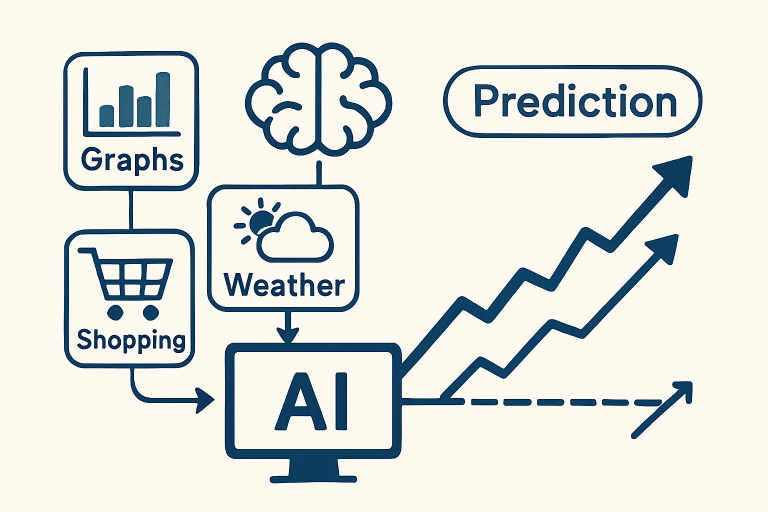Predicting Tomorrow: The New Era of AI-Driven Forecasting
The Shift from Traditional to AI-Driven Forecasting
Over the years, traditional demand forecasting methods have depended heavily on linear models and historic sales data, which often fall short in today’s volatile marketplace. The adoption of AI-driven forecasting has significantly altered this landscape by utilizing advanced machine learning algorithms to analyze large datasets, encompassing real-time market signals, weather, macroeconomic indicators, and social sentiment. Leveraging these systems can be crucial for any organization seeking to achieve more accurate forecasts and responsive business strategies, prompting companies to seek a robust revenue management solution that seamlessly integrates AI into their operations.
Unlike earlier statistical models that only uncover basic trends, AI-powered demand forecasting processes vast data streams in real time, identifying intricate patterns and correlations. By understanding what drives customer demand from multiple angles, companies reduce the possibility of overstocking or losing sales to competitors during unexpected surges in demand. This shift is particularly pronounced in sectors where even minor miscalculations can lead to missed opportunities or costly inventory issues.
AI systems not only process more data but also adapt quickly as new information becomes available. This dynamic adaptability is especially valuable in industries facing unpredictable market changes or evolving consumer preferences. The days of relying solely on past sales as a signal for the future are fading as AI solutions become an essential part of the business decision-making toolkit.
Industry leaders embracing AI in demand forecasting not only gain insights into the “what” and “when” but also deeper visibility into the “why,” empowering smarter, data-driven decisions.
Real-Time Data Integration for Enhanced Accuracy
AI-powered platforms excel at integrating and analyzing disparate data sources, including weather trends, economic shifts, digital engagement metrics, and customer buying patterns. This multidimensional approach enables organizations to capture the full spectrum of factors affecting demand and adapt instantly to new developments. By continuously monitoring channels, ranging from social media to point-of-sale data, AI systems can spot early warning signals that traditional models might overlook. This responsive forecasting enables businesses to manage their inventory more effectively, mitigate the risks of stockouts, and capitalize on new opportunities in fast-moving markets.

Case Studies: AI in Action
Numerous leading companies demonstrate the real-world impact of AI-enhanced demand forecasting:
- Kraft Heinz: The company responded to supply chain volatility by leveraging AI to overhaul its forecasting capabilities. With machine learning models, Kraft Heinz achieved an 8% monthly improvement in forecast accuracy and reduced excess inventory by 25%. These changes also resulted in a 10% reduction in food waste and ensured stronger product availability during market disruptions.
- Amazon: AI-driven algorithms allow Amazon to predict daily demand across more than 400 million products. Factoring in regional shopping patterns, search data, local events, and weather, these models have slashed excess inventory by 30% and improved delivery accuracy by 40%.
Implementing AI in Demand Forecasting
Successful AI adoption begins with a clear understanding of your organization’s goals and the unique demand challenges specific to your business. Begin by assessing priorities, whether it’s minimizing surplus inventory, bolstering service levels, or developing flexible production schedules.
- Assess Business Needs: Carefully define what outcomes you expect from AI implementation.
- Choose the Right Providers: Select AI solutions and partners with proven expertise and a track record in your specific market segment.
- Utilize High-Quality Data: Invest in data collection, integration, and cleansing to ensure optimal model performance.
- Involve Stakeholders: Educate teams about the benefits of AI, establish data governance, and address concerns related to ethics, privacy, and bias from the outset.
- Monitor and Iterate: Continuously refine AI models as new data becomes available and market dynamics change.
Challenges and Considerations
- Data Quality: AI models depend on rich, clean data. Poor-quality or incomplete data can introduce errors into forecasting results and erode confidence in decision-making.
- Integration with Existing Systems: Many organizations must upgrade their legacy IT infrastructure or overhaul business processes to support the deployment of AI.
- Skill Gaps: Implementing advanced analytics often requires hiring or upskilling a workforce to manage and interpret new tools and results.
The Future of AI in Demand Forecasting
- Edge Computing and IoT Integration: As real-time insights become more valuable, the use of edge computing and IoT devices is accelerating. These technologies enable businesses to analyze fresh data at the source, providing immediate forecasting feedback and supporting agile, on-the-fly decision-making.
- Explainable AI: New tools are enhancing transparency in AI models, which is crucial for gaining stakeholder buy-in and meeting regulatory requirements, particularly in industries where auditability and interpretability are paramount.
Staying on top of these trends ensures organizations remain agile and can continually optimize their demand forecasting for competitive advantage.
Conclusion
AI is setting a new standard in demand forecasting, empowering organizations to make data-driven decisions that improve supply chain resilience and operational agility. While challenges relating to data quality, integration, and talent exist, the opportunity for smarter insights and greater efficiency makes incorporating AI a vital investment for businesses intent on thriving in dynamic markets.
Visit the rest of the site for more interesting and useful articles.

